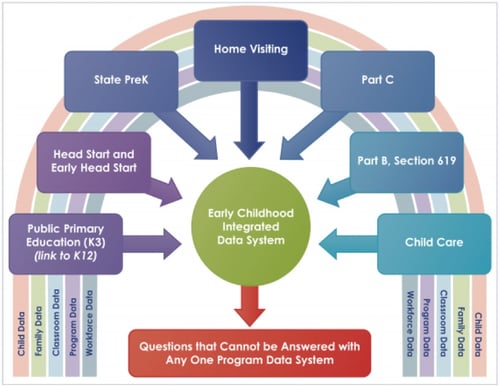Recent state work on Early Childhood Integrated Data Systems (ECIDS) has required representatives from multiple programs that provide early childhood services. Among those programs are IDEA Part C and Part B Section 619, which have been early priorities for ECIDS integration.
Most states working on an ECIDS now include, or are planning to include, Part C Early Intervention and Part B Section 619 Early Childhood Special Education data. However, in states that have successfully integrated this data, programs face limited access to the type of data and reporting features that would best support their work.
Many IDEA Part C and Part B Section 619 coordinators and data managers are ready to participate in ECIDS but must collaborate and leverage existing resources so that they can participate more broadly and deeply. In other words, more states must integrate data and those that do must improve programs’ access to valuable data and reporting features.
There are two major reasons why Part C and Part B Section 619 data leaders should prioritize participation in ECIDS. We review these reasons in this post through the lens of the experience of the State of Minnesota, and close by sharing some key resources that can provide support to all data leaders.
 Source: What is an Early Childhood Integrated Data System?
Source: What is an Early Childhood Integrated Data System?
Since the 1986 establishment of Part C and mandate of Part B Section 619, statewide data systems have housed basic demographic and enrollment data. Programs have reported data for compliance purposes, which has focused on the program level rather than the child level.
As the focus of the national conversation has shifted from using data for compliance to using data for continuous quality improvement, program leads have been exploring ways to use integrated data on early intervention and early childhood special education for decision-making. In fact, a recent study found that Part C coordinators want to use data to make decisions about more than just child outcomes: they want to use it to make fiscal decisions and to examine the quality of programs and satisfaction of families. Integrated data can help answer key questions to inform decisions at the state, local, and program levels on many of these key topics of interest.
Minnesota has been a leader in early childhood data systems work. Unsurprisingly, they have excelled in the collaboration required for ECIDS work, and have found value in integrating Part C and Part B Section 619 data. For Minnesota’s Part C leadership, the ECIDS has served as an opportunity to help others within and outside of their agency understand their work and their data:
In the broader field, there is a strong interest in using ECIDS data to answer questions to support continuous improvement of programs and services. The DaSy Center’s Critical Questions about Early Intervention and Early Childhood Special Education include examples, such as:
These questions about child outcomes and early childhood systems, among many others, have been prioritized by Part C and Part B Section 619 staff and documented in the Critical Questions resource.
As Part C and Part B Section 619 staff work with ECIDS leads to integrate their data into the ECIDS, they are doing much more than connecting data; they are establishing new relationships and taking advantage of opportunities for collaboration. For example, Minnesota’s data manager Lisa Backer reports:
“So much of the work that we do at the state level is strengthened by relationships. Being at the table and contributing to the work has strengthened those important relationships horizontally across other agencies and programs serving young children and vertically with other agencies and programs serving children with disabilities as they move into the K-12 system.”
Even if you see the value, it’s not always easy to see where to start. The good news is that there are myriad resources to support the various components of ECIDS work including data integration, data use, stakeholder engagement, privacy and confidentiality, and more.
For example, the Statewide Longitudinal Data System funding and technical assistance team provides resources to support the use of data from ECIDS and the incorporation of new partners. ECDataWorks supports partnership building in states and the development of innovative analytic tools that use ECIDS data. The Education Data Technical Assistance Program (EDTAP) and the Privacy Technical Assistance Center (PTAC) have collaborated to provide resources, webinars, workshops, and on-site TA to help states work through challenges and leverage each other’s work. The DaSy Center has created stakeholder engagement modules that support Part C and Part B Section 619 staff in participating in and leading others in data systems work. DaSy has also developed a guide that outlines considerations for Part C and Section 619 programs when joining the ECIDS conversation.
When deciding whether to pursue participation in an ECIDS, Part C and Part B Section 619 leadership should consider the value of improving data use and building new partnerships across early childhood. They should leverage the successes of others and make use of existing supports and resources. Though Part C and Part B Section 619 leadership may feel they are on this journey alone, there are others out there. The value of data integration makes for a very worthwhile challenge.
For more information, we suggest the following sites and resources:
We tend to think about child care as a family issue and a business issue. Four decades ago, the fact is that child care became a “military readiness” issue when the draft was eliminated in favor of an all-volunteer force. With the resulting influx of families and children, child care was needed to reduce the conflict between military mission requirements and parental responsibilities.
Yes, it is important to go to your office or cubicle and perform the day-to-day routines of collecting data, reporting federal and state data, and running ad-hoc data requests.
This post was co-authored by Ruth Lett and Nancy Copa.